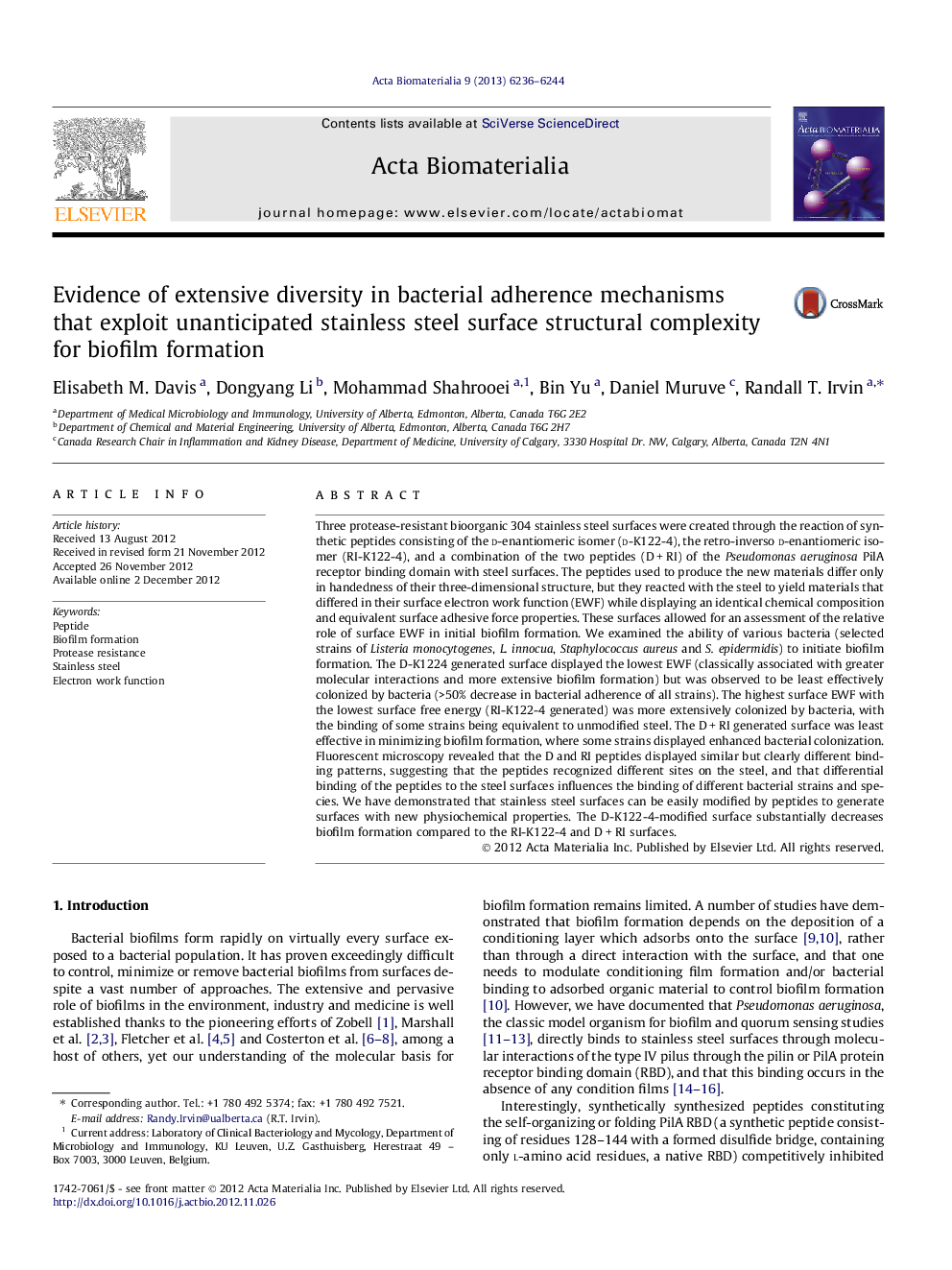| کد مقاله | کد نشریه | سال انتشار | مقاله انگلیسی | نسخه تمام متن |
|---|---|---|---|---|
| 10159880 | 59 | 2013 | 9 صفحه PDF | دانلود رایگان |
عنوان انگلیسی مقاله ISI
Evidence of extensive diversity in bacterial adherence mechanisms that exploit unanticipated stainless steel surface structural complexity for biofilm formation
ترجمه فارسی عنوان
شواهد تنوع گسترده ای در مکانیسم های پایداری باکتریایی که از پیچیدگی ساختاری سطحی ناخالص داخلی برای ایجاد بیوفیلم بهره برداری می کنند
دانلود مقاله + سفارش ترجمه
دانلود مقاله ISI انگلیسی
رایگان برای ایرانیان
کلمات کلیدی
موضوعات مرتبط
مهندسی و علوم پایه
مهندسی شیمی
بیو مهندسی (مهندسی زیستی)
چکیده انگلیسی
Three protease-resistant bioorganic 304 stainless steel surfaces were created through the reaction of synthetic peptides consisting of the d-enantiomeric isomer (d-K122-4), the retro-inverso d-enantiomeric isomer (RI-K122-4), and a combination of the two peptides (DÂ +Â RI) of the Pseudomonas aeruginosa PilA receptor binding domain with steel surfaces. The peptides used to produce the new materials differ only in handedness of their three-dimensional structure, but they reacted with the steel to yield materials that differed in their surface electron work function (EWF) while displaying an identical chemical composition and equivalent surface adhesive force properties. These surfaces allowed for an assessment of the relative role of surface EWF in initial biofilm formation. We examined the ability of various bacteria (selected strains of Listeria monocytogenes, L. innocua, Staphylococcus aureus and S. epidermidis) to initiate biofilm formation. The D-K1224 generated surface displayed the lowest EWF (classically associated with greater molecular interactions and more extensive biofilm formation) but was observed to be least effectively colonized by bacteria (>50% decrease in bacterial adherence of all strains). The highest surface EWF with the lowest surface free energy (RI-K122-4 generated) was more extensively colonized by bacteria, with the binding of some strains being equivalent to unmodified steel. The DÂ +Â RI generated surface was least effective in minimizing biofilm formation, where some strains displayed enhanced bacterial colonization. Fluorescent microscopy revealed that the D and RI peptides displayed similar but clearly different binding patterns, suggesting that the peptides recognized different sites on the steel, and that differential binding of the peptides to the steel surfaces influences the binding of different bacterial strains and species. We have demonstrated that stainless steel surfaces can be easily modified by peptides to generate surfaces with new physiochemical properties. The D-K122-4-modified surface substantially decreases biofilm formation compared to the RI-K122-4 and DÂ +Â RI surfaces.
ناشر
Database: Elsevier - ScienceDirect (ساینس دایرکت)
Journal: Acta Biomaterialia - Volume 9, Issue 4, April 2013, Pages 6236-6244
Journal: Acta Biomaterialia - Volume 9, Issue 4, April 2013, Pages 6236-6244
نویسندگان
Elisabeth M. Davis, Dongyang Li, Mohammad Shahrooei, Bin Yu, Daniel Muruve, Randall T. Irvin,
